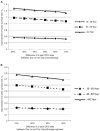Clinical and economic impact of multiple gated acquisition scan monitoring during anthracycline therapy
- PMID: 11870511
- PMCID: PMC2375190
- DOI: 10.1038/sj.bjc.6600037
Clinical and economic impact of multiple gated acquisition scan monitoring during anthracycline therapy
Abstract
The clinical and economic impacts of monitoring cardiac function in patients given doxorubicin have yet to be determined, especially in relation to patient age, cumulative doxorubicin dose, and the relative efficacies of doxorubicin-based vs alternative regimens. We developed a decision analysis model that includes these factors to estimate the incremental survival benefit and cost-effectiveness of using multiple gated acquisition scans to measure left-ventricular ejection fraction before and during doxorubicin chemotherapy. Probability distributions for the incidences of abnormal left-ventricular ejection fraction findings and congestive heart failure were derived from a retrospective review of 227 consecutive cases at The University of Michigan Medical Center and published findings. Multiple gated acquisition-scan monitoring minimally improved the probability of 5-year survival (<1.5% in the base--case scenario). For patients who received up to 350 mg m(-2) of doxorubicin, multiple gated acquisition-scan screening had an incremental cost of $425 402 per life saved for patients between the ages of 15--39. This incremental cost markedly decreased to $138 191, for patients between the ages of 40--59, and to $86 829 for patients older than 60 years. The small gain in 5-year survival probability secondary to multiple gated acquisition scan monitoring doubled for all age groups when the average cumulative dose for doxorubicin reached 500 mg m(-2). Variations in the cure rate differences between the doxorubicin and alternative regimens had insignificant effects on the improvement in 5-year survival rates from multiple gated acquisition-scan screening. The use of multiple gated acquisition scans for pretreatment screening appears to be more cost-effective for patients who are 40 years or older, when cumulative doxorubicin dose is 350 mg m(-2) or less.
Copyright 2002 The Cancer Research Campaign
Figures




References
-
- BennettJMAndersenJWBeggCBGlickJH1993Age and Hodgkin's disease: the impact of competing risks and possibly salvage therapy on long term survival: an E.C.O.G. study Leuk Res 17825832 - PubMed
-
- BonadonnaGValagussaPSantoroA1986Alternating non-cross-resistant combination chemotherapy or MOPP in stage IV Hodgkin's disease. A report of 8-year results Ann Intern Med 104739746 - PubMed
-
- CarrioIEstorchMLopez-PousaA1996Assessing anthracycline cardiotoxicity in the 1990s Eur J Nucl Med 23359364 - PubMed
-
- DracupKBakerDWDunbarSBDaceyRABrooksNHJohnsonJCOkenCMassieBM1994Management of heart failure. II. Counseling, education, and lifestyle modifications JAMA 27214421446 - PubMed
-
- EsteyEdeLimaMStromSPierceSFreireichEJKeatingMJ1997Long-term follow-up of patients with newly diagnosed acute myeloid leukemia treated at the University of Texas M. D. Anderson Cancer Center Cancer 8021762180 - PubMed
MeSH terms
Substances
LinkOut - more resources
Full Text Sources
Medical

